
Parthenope is a large, bright main-belt asteroid.
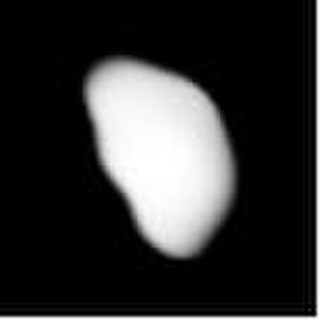
Victoria is a large main-belt asteroid, orbiting the Sun with a period of 3.56 years and an eccentricity of 0.221. It is a stony (S-type) asteroid, about 112–124 km across with an albedo of 0.18 and a rotation period of 8.66 hours. Victoria has been observed to occult a star three times since its discovery. Radar and speckle interferometry observations show that the shape of Victoria is elongated, and it is suspected to be a binary asteroid, with a moon of irregular shape.
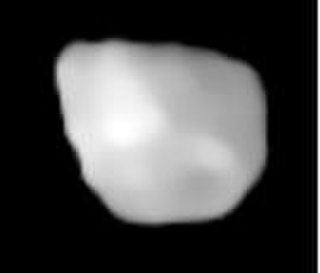
Egeria is a large main-belt G-type asteroid. It was discovered by Annibale de Gasparis on November 2, 1850. Egeria was named by Urbain Le Verrier, whose computations led to the discovery of Neptune, after the mythological nymph Egeria of Aricia, Italy, the wife of Numa Pompilius, second king of Rome.

Irene is a large main-belt asteroid, discovered by the English astronomer John Russell Hind on May 19, 1851. It is orbiting the Sun at a distance of 2.585 AU with a period of 4.16 yr and an eccentricity of 0.168. The orbital plane is tilted at an angle of 9.1° to the plane of the ecliptic.
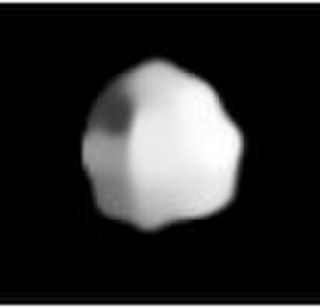
Melpomene is a large, bright main-belt asteroid that was discovered by J. R. Hind on 24 June 1852, and named after Melpomenē, the Muse of tragedy in Greek mythology. Its historical symbol was a dagger over a star; it is in the pipeline for Unicode 17.0 as U+1CECB .

Bellona is a large main-belt asteroid. It was discovered by German astronomer R. Luther on March 1, 1854, and named after Bellōna, the Roman goddess of war; the name was chosen to mark the beginning of the Crimean War. Its historical symbol was Bellona's whip and spear; it is in the pipeline for Unicode 17.0 as U+1CECE .

Leukothea is a large, dark asteroid from the asteroid belt. It was discovered by German astronomer Karl Theodor Robert Luther on April 19, 1855, and named after Leukothea, a sea goddess in Greek mythology. Its historical symbol was a pharos ; it is in the pipeline for Unicode 17.0 as U+1CED0 .
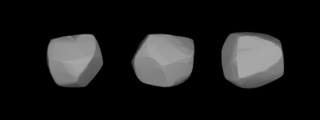
Fides is a large main-belt asteroid. It was discovered by German astronomer Karl Theodor Robert Luther on October 5, 1855, and named after Fides, the Roman goddess of loyalty. Fides was the last of the main-belt asteroids to be assigned an iconic symbol, a Latin cross U+271D ✝. 37 Fides is also a S-type asteroid in the Tholen classification system.

Mnemosyne is a large main belt asteroid. It is a stony S-type asteroid in composition. This object was discovered by Robert Luther on 22 September 1859 in Düsseldorf. Its name was chosen by Martin Hoek, the director of the Utrecht Observatory, in reference to Mnemosyne, a Titaness in Greek mythology.

Adria is a fairly large main-belt asteroid that was discovered by Austrian astronomer Johann Palisa on 23 February 1875, at the Austrian Naval Observatory, and named after the Adriatic Sea, on the coast of which the discovery was made. This dark-coloured asteroid has probably a primitive carbonaceous chondritic composition.
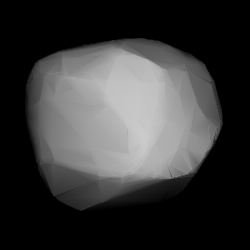
Aemilia is a large main-belt asteroid. Aemilia was discovered by the French brothers Paul Henry and Prosper Henry on January 26, 1876. The credit for this discovery was given to Paul. It is probably named after the Via Aemilia, a Roman road in Italy that runs from Piacenza to Rimini.
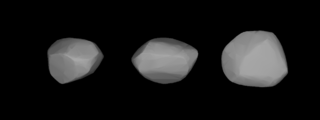
Kriemhild is a main belt asteroid that was discovered by Austrian astronomer Johann Palisa on 22 September 1884 in Vienna and was named after Kriemhild, a mythological Germanic princess, by Moriz von Kuffner, a Viennese industrialist and sponsor of astronomy.

Eduarda is a main belt asteroid that was discovered by German astronomer Max Wolf on 25 September 1892 in Heidelberg. It was named after German banker and amateur astronomer Heinrich Eduard von Lade.

Myrrha is a main-belt asteroid that was discovered by the French astronomer Auguste Charlois on January 10, 1894, in Nice. It has been classified as a C-type asteroid and is most likely composed of carbonaceous material.
Merapi is a main belt asteroid orbiting the Sun. It was discovered by American astronomer George Henry Peters on May 11, 1904, from Washington, D.C.
Suleika is a minor planet orbiting the Sun. Previously designated as 1905 QK, it was discovered by German astronomer Paul Götz on 6 April 1905 from Heidelberg, Germany.

665 Sabine is a minor planet orbiting the Sun that was discovered by German astronomer Wilhelm Lorenz on July 22, 1908.
799 Gudula is a minor planet orbiting the Sun discovered by German astronomer Karl Wilhelm Reinmuth on 9 March 1915 at the Heidelberg observatory.
4175 Billbaum, provisional designation 1985 GX, is a background asteroid from the central regions of the asteroid belt, approximately 9 kilometers in diameter. It was discovered on 15 April 1985, by American astronomer Edward Bowell at the Anderson Mesa Station of the Lowell Observatory near Flagstaff, Arizona. The uncommon L-type asteroid has a short rotation period of 2.73 hours and was named for American astronomer William A. Baum.
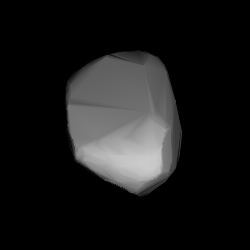
1621 Druzhba, provisional designation 1926 TM, is a stony Florian asteroid and relatively slow rotator from the inner regions of the asteroid belt, approximately 10 kilometers in diameter. It was discovered on 1 October 1926, by Russian astronomer Sergey Belyavsky at Simeiz Observatory on the Crimean peninsula. It was named after the Russian word for friendship.

![]() ). [7] [8]
). [7] [8] 














